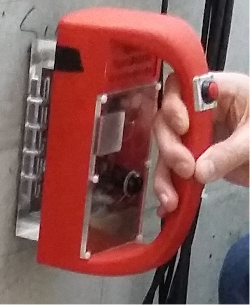
Background
Picture : Capacitive probes – © IFSTTAR
The aim of the CA2M-COM project consists in regrouping and organizing the available data and pacing them against the models of chloride penetration to analyze which indicators (inputs) or which monitoring parameters (outputs), until now validated by destructive profiles, could be replaced by results of Non-Destructive Evaluation (NDE) methods.
One of the main causes of degradation of the reinforced concrete structures (RC) in maritime environment (quays, floating wind mill) is indeed the corrosion of reinforcements due to the chloride penetration coming from sea water.
The Non-Destructive Evaluation (NDE) methods, based on the wave propagation (ultrasonic, electric and electromagnetic), are more and more used to survey civil engineering structures. The development of these techniques is of primary interest for the survey of marine structures. Indeed, coring in such marine environment and conditions is difficult and expensive whereas the ND tests can make it possible to reduce the number of cores necessary to cartography the studied structure. The results of these methods are called “observable”.
Scientific advances and innovation
The long-term objective of the CA2M-COM project is to use directly the ND results in the models of penetration of water and aggressive agents, in order to predict the deterioration of the concrete floating part of an offshore windmill.
Expected technical and economic impact
The CA2M-COM project is a beginning to improve the NDE survey and assessment of reinforced concrete structure in marine environment, then to improve the diagnosis and prognosis of their lifetime duration for maintenance perspectives.
Key project milestones
- March 2018 - Beginning of the project
- July 2018 - Report and presentation of the Master2 student
- October 2018 - Proposition of a structure survey program
Results
Khodor El Achrafi pursued an internship in the LAMES/MAST laboratory (Université Gustave Eiffel). Firstly, he built a database including the mix designs, the conditions of tests and the results of the destructive and nondestructive tests available for lab tests issuing from ORSI-APOS project. He used the models of Tang and Nilsson for the chloride penetration by diffusion in saturated concretes. He analyzed the indicators obtained by fitting the profiles obtained by destructive and non-destructive method. He show the interest in using END profiles in particular to observe the evolution of the diffusion coefficient with time. Secondly, he completed the database by results obtained on site in 2007 by END and destructive methods on cores from 4 reinforced concrete beams in Nantes-Saint-Nazaire harbor. He used the model to predict the chloride penetration in 2018 to test some cases of application and finally to propose a program of nondestructive survey to apply to a RC structure located in tidal zone.
Prospects
It would be particularly interesting to extend this study to the complete durability models describing chloride penetration in tidal zone or in sometimes submerged zone, in order to apply them to the reinforced concrete structures of offshore windmills.






